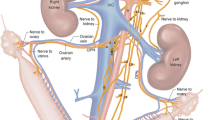Summary
A topographical study concerning the autonomic nerves in the pelvis of human fetuses was performed by investigating 300–600 μm thick sections through fetal pelves, impregnated with the epoxy resin E 12 and cut with a diamond wire-saw. In addition the inferior hypogastric plexus of a 26-week old male fetus was dissected by lateral approach. In 21–29-week old fetuses the pelvic autonomic nerves are relatively thick. Thus the nerves stand out well against surrounding structures and their topographical relationships can exactly be determined. The inferior hypogastric plexus of 21–29-week old fetuses is situated on a curved line between the rectum and the ventrally adjacent structure. It constitutes a rectangular plate, which cannot be subdivided into individual plexuses for the different pelvic organs. The fetal plexus is heavily ganglionated. Large ganglia, forming the so-called ganglion of “Frankenhaeuser”, are found in the female as well as in the male fetus. In the fetal pelvis the connective tissue compartments are still clearly arranged, because adipose tissue is not yet abundant. The greater part of the inferior hypogastric plexus is situated exactly at the border between a dense visceral tissue medially and a loose parietal tissue laterally. The plexus does not share a common connective tissue cover with the pelvic blood vessels. In fetuses the inferior hypogastric plexus lies in close vicinity to serveral organs, but the pelvic floor is the only region where the nerves can hardly be separated from the surrounding structures.
Similar content being viewed by others
References
Baljet B, Drukker J (1981) Some aspects of the innervation of the abdominal and pelvic organs in the human female fetus. Acta Anat 111:222–230
Blok S De (1982) The connective tissue of the female fetal pelvic region. Acta Morphol Neerl Scand 20:65–92
Curtis AH, Anson BJ, Ashley FL, Jones T (1942) The anantomy of the pelvic autonomic nerves in relation to gynecology. Surg Gynecol Obstet 75:743–750
Frankenhaeuser F (1867) Die Nerven der Gebaermutter und ihre Endigungen in den glatten Muskelfasern. Mauke, Jena
Fritsch H (1988) Developmental changes in the retrorectal region of the human fetus. Anat Embryol 177:513–522
Goetze O (1951) Chirurgische Beobachtungen zur vegetativen Innervation der Becken-Organe, speziell des After-Schließmuskels. Dtsch Z Nervenheilkd 166:177–188
Hagens G von (1985) Heidelberger Plastinationshefter. Anatomisches Institut I, Universität Heidelberg, D-6900 Heidelberg, FRG
Hayek H von (1969) Die Innervation der Backnorgane. In: Alken CE, Dix VW, Goodwin WE, Wildbolz E (eds) Handbuch der Urologie. Springer, Berlin Heidelberg New York, pp 512–517
Hovelacque A (1927) Anatomie des nerfs craniens et rachidiens et du système grand sympathique chez l'homme. Gaston Doin et Cie, Paris
Kimmel DL, McCrea LE (1958) The development of the pelvic plexuses and the distribution of the pelvic splanchnic nerves in the human embryo and fetus. J Comp Neurol 110:271–297
Kuntz A (1947) The autonomic nervous system. Lea & Febiger, Philadelphia
Kuntz A (1952) Origin and early development of the pelvic neural plexus. J Comp Neurol 96:345–357
Laczkó J, Lévai G (1975) A simple staining method for semithin sections of ossifying cartilage and bone tissue embedded in epoxy resin. Mikroskopie 31:1–4
Lepor H, Gregerman M, Crosby R, Mostofi FK, Walsh PC (1985) Precise localization of the autonomic nerves from the pelvic plexus to the corpora cavernosa: A detailed anatomical study of the adult male pelvis. J Urol 133:207–212
Long DM, Bernstein WC (1959) Sexual dysfunction as a complication of abdomino-perineal resection of the rectum in male. Dis Colon Rectum 2:540–548
Mitchell GAG (1953) Anatomy of the autonomic nervous system. E & S Livingstone LTD, Edinburgh, London
Moore KL (1977) The developing human, 2nd edn. WB Saunders Book Company, Philadelphia London Toronto
Patten BM (1968) Human Embryology, 3 edn. Mc Graw-Hill Book Company, New York Toronto Sydney London
Pernkopf E (1941) Topographische Anatomie des Menschen Bd 2, Teil 2. Urban und Schwarzenberg, Berlin
Pick J (1970) The autonomic nervous system: Morphological, comparative, clinical and surgical aspects. Lippincott, Philadelphia
Schwab K, Hagens G von (1981) Freeze substitution of macroscopic specimens for plastination. Sixth European Anatomical Congress, Acta Anat 111:139–140
Stelzner F (1977) Über Potenzstörungen nach Amputation und Kontinenzresektion des Rektums. Zentralbl Chir 102:212–219
Stelzner F, Fritsch H, Fleischhauer K (1989) Die chirurgische Anatomie der Genitalnerven des Mannes und ihre Schonung bei der Exzision des Rektums. Chirurg 60:228–234
Walsh PC, Donker PJ (1982) Impotence following radical prostatectomy: insight into etiology and prevention. J Urol 128:492–497
Walsh PC, Lepor U, Eggleston JC (1983) Radical Prostatectomy with preservation of sexual function: anatomical and pathological considerations. Prostate 4:473–485
Author information
Authors and Affiliations
Rights and permissions
About this article
Cite this article
Fritsch, H. Topography of the pelvic autonomic nerves in human fetuses between 21–29 weeks of gestation. Anat Embryol 180, 57–64 (1989). https://doi.org/10.1007/BF00321900
Accepted:
Issue Date:
DOI: https://doi.org/10.1007/BF00321900




